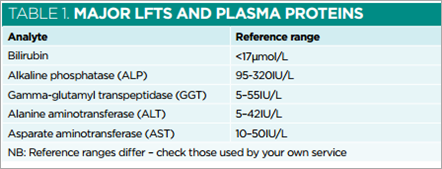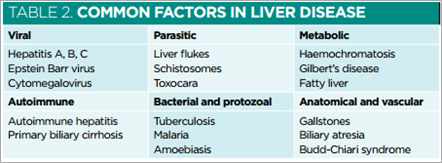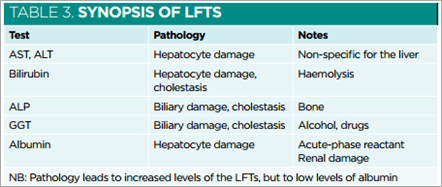Provided by Nursing Times
Practice educator
31 January, 2014
Author
Andrew Blann is a consultant at City Hospital, Birmingham, and senior lecturer in medicine, University of Birmingham.
ABSTRACT
Blann A (2014) Routine blood tests 2: what is the purpose of liver function tests? Nursing Times; 110: 6, 17-19.
The liver is the body’s largest single discrete organ. It has four major functions: metabolism and synthesis; excretion; storage; and the detoxification of potential poisons. These diverse functions mean that a single test does not give enough information to assess fully how the liver is functioning; at least five different liver function tests are required.
This article, part 2 in a four-part series, discusses the information on acute and chronic liver disease that these tests can provide, and how disease affects liver function.
- This article has been double-blind peer reviewed
- Figures and tables can be seen in the attached print-friendly PDF file of the complete article in the ‘Files’ section of this page
5 KEY POINTS
- The liver plays an important role in synthesis, excretion, storage and detoxification
- Its multiple metabolic and excretory functions mean disease of the liver can have serious consequences
- The most obvious indication of liver disease is jaundice, a sign of high levels of bilirubin
- Although the liver largely regenerates after damage, if damage is prolonged it loses its ability to do so
- There are few clinical situations where a diagnosis can be made based on a single blood test
The liver, the largest single discrete organ in the body, has four main functions and plays a major part in many metabolic and excretory processes. Due to its multiple functions, liver disease has numerous consequences, many of which can be detected and monitored with blood tests known as liver functions tests (LFTs).
Main functions of the liver
Synthesis
The liver produces and exports many proteins and lipids into the blood, so reduced levels of certain proteins (such as albumin and clotting proteins) may indicate damage to the liver. The liver also synthesises fatty acids, triacylglycerols and cholesterol, but the levels of these lipids are not regarded as markers of liver function.
Excretion
When red blood cells die much is recycled, and what cannot be recycled is converted into bilirubin. Some bilirubin moves as bile into the gall bladder, while some immediately flows down the bile duct and through the duodenum, colouring the faeces brown.
The liver plays a significant role in removing excess nitrogen from the body through the production of urea.
Storage
Glucose is converted into the polysaccharide glycogen, which is stored in the liver. When there is too much glucose, it is converted into fat, which can be deposited in the liver and elsewhere. The liver also stores iron, vitamins, and copper.
Detoxification
In addition to synthesis and recycling, the liver has a role in detoxification. This includes metabolising plant, animal and fungal toxins (such as the fungal aflatoxin), as well as drugs and medication.
Liver disease
To carry out its diverse metabolic tasks, the liver uses several enzymes (Table 1). These help to link many of the liver’s functions to specific or non-specific tests; for many, the most obvious indication of liver disease is jaundice, a sign of high bilirubin levels.

Jaundice
Jaundice is a clear sign of liver disease, and is present when blood levels of bilirubin are so high (generally greater than 40mmol/L), that it enters the skin. This is most apparent in the sclera (white) of the eye. Jaundice is also called icterus and can develop in three ways: haemolytic, following red cell destruction; damage to liver cells; and failure to excrete bile, most likely due to obstruction.
At such high levels in the blood, this bilirubin finds its way to the kidney and into the urine, which becomes dark yellow and possibly orange/brown; this is an additional important clinical sign.
Cholestasis
This common condition is caused by obstruction or stenosis of the bile duct by, for example, gallstones or a tumour. This prevents the liver and biliary system from excreting bile, leading to obstructive cholestasis.
Inflammatory cholestasis occurs when inflammation of the bile duct prevents bile from passing into the duodenum; the liver continues to generate bile, which fills the gall bladder leading to congestion. Once the gall bladder is full, bile cannot leave the liver and it passes into the blood causing jaundice. A further sign of cholestasis is a change in the colour of the faeces from brown to grey, a likely indication that bile is not entering the intestines.
Cirrhosis
If damaged, such as after a viral infection or exposure to a poison, the liver has a remarkable capacity to regenerate.
However, if the damage is prolonged, for example due to a chronic infection, the renewal processes may be unable to continue regenerating functioning liver cells, leading to fibrous tissues being deposited instead. Cirrhosis can be the end result of several lengthy pathological processes, including: autoimmune diseases; chronic hepatitis virus B infection; longstanding biliary obstruction; and alcohol misuse.
Eventually, the loss of functioning cells may lead to chronic liver failure, and possibly liver cancer.
Ascites
Ascites is the excessive accumulation of plasma-like fluid in the peritoneal cavity. In up to 75% of patients, it is a consequence of advanced cirrhosis leading to portal hypertension. Other causes include heart failure, cancer and inflammation (Senousy and Draganov, 2009).
Cancer
The primary malignancy of the liver is hepatocellular carcinoma (HCC). According to Cancer Research UK (2014), it makes up 1.3% of cancers, and well over 3,000 new cases arise each year.
HCC is also sometimes referred to as hepatoma, but technically this means a mass within the liver that may not necessarily be a malignancy.
The vast majority of liver cancer occurs in the liver cells (hepatocytes) themselves; cancer of the bile ducts - cholangiocarcinoma - is less common.
The main causes of liver cancer are chronic viral infection (hepatitis B and C) and long-term alcohol misuse. The key laboratory test for this type of cancer is alpha-fetoprotein (AFP); however, if the liver is the site of a secondary cancer (metastasis), AFP will be negative.
Fatty liver (steatosis)
Fat is effective for storing energy, and large deposits can be found in various parts of the body, such as around the heart and liver.
However, if fat intake is excessive, in certain rare metabolic conditions and if alcohol is misused, fat starts to be stored in the liver. In the absence of alcohol misuse, this leads to non-alcohol fatty liver disease, which in its mild form is described as steatosis.
The damage caused by lipid overloading leads to hepatocellular damage, inflammation and fibrosis, and the disease transforms to non-alcoholic steatohepatitis (NASH). This progresses to cirrhosis in about 5-8% of patients within five years, and may be complicated by hepatocellular carcinoma and liver failure (Adams and Angulo, 2006). NASH may be secondary to a number of conditions including diabetes, impaired fasting glycaemia, malnutrition, hypertension and obesity.
There are many other less common liver diseases, some of which are in Table 2.

Liver function tests
The interpretation of LFTs is complicated: there are few examples of clinical situations where a single blood test is sufficiently reliable to diagnose a precise disease, so practitioners need to gather as much information as possible before making a clinical judgement.
Aspartate aminotransferase (AST) and alanine aminotransferase (ALT)
Increased levels of these enzymes are traditionally seen as markers of damage to liver cells, which could have any one of several causes including infective agents, autoimmune disorders and toxins.
Infections with microbial pathogens all cause an increase in AST and/or ALT, although the latter is better for monitoring viral activity in chronic hepatitis B and C as it is released from damaged hepatocytes more easily.
AST and ALT are found in many non-liver cells, including skeletal and cardiac muscle, so raised levels following a heart attack do not necessarily imply liver disease. Similarly, raised AST is commonly found in haemolytic anaemia as this enzyme is present in red blood cells. Another blood test, lactate dehydrogenase (LDH), can be helpful in confirming the diagnosis of haemolytic anaemia.
Many drugs and toxins can also raise AST and/or ALT levels. These include alcohol, industrial solvents and cholesterol-lowering drugs of the statin class.
Bilirubin
This has been described as the only true LFT, as clearing this potential toxin is a major liver function. Although the most common non-hepatic cause of raised bilirubin is excessive haemolysis, true liver disease, such as Wilson’s disease, may also cause red blood cell destruction and anaemia.
Bilirubin in neonates deserves special mention. The neonatal liver is under-developed and shortly after birth may not be mature enough to process its own bilirubin. This may lead to hyperbilirubinaemia and jaundice, which should normalise within 2-3 days after birth as the liver matures.
Alkaline phosphatase (ALP)
The most common cause of raised ALP is obstruction of the bile duct or its tributaries (cholestasis), commonly caused by gallstones. Primary biliary cirrhosis and pancreatic malignancy also cause an increase in ALP levels.
The major non-hepatic source of plasma ALP is bone, and raised levels are found in the absence of liver disease in patients with metabolic bone disease, such as Paget’s disease. Increased ALP may also be present in a primary or secondary bone cancer (typically metastases from prostate and breast cancer).
Gamma-glutamyl transpeptidase (gamma-GT)
There are numerous hepatic and non-hepatic causes of raised gamma-glutamyl transpeptidase (gamma-GT); it is often present in: cirrhosis or hepatitis; haemochromatosis; HCC; and secondary cancer.
Gamma-GT levels are also influenced by several commonly used drugs, such as phenytoin, barbiturates, carbamazepine and alcohol, which make this test less reliable.
Comparing the LFTs
In paracetamol poisoning, AST needs to be considered alongside bilirubin in assessing prognosis using serial results, perhaps over a period of a week.
If the AST and bilirubin fall in parallel, it suggests hepatic recovery and good prognosis. However, a falling AST with a rising bilirubin indicates critical loss of hepatocytes and a poor prognosis.
The ratio of the aminotransferases can be helpful. An AST:ALT ratio greater than 2:1 implies alcohol misuse because of the release of mitochondrial AST due to damage from alcohol metabolites.
A rise in AST may also be compared with rises in ALP; if AST is higher, this is suggestive of hepatitis. ALP and gamma‑GT often rise and fall together in many conditions, but ALP is the better marker of biliary and bone disease and GGT of alcoholic disease.
Table 3 gives a synopsis of the LFTs.

● This article was adapted from: Blann AD (2013) Routine Blood Tests Explained. Keswick: M&K Update.
References:
Adams LA, Angulo P (2006) Treatment of non-alcoholic fatty liver disease. Postgraduate Medical Journal; 82, 315-322.
Cancer Research UK (2014) Twenty Most Common Cancers.
Senousy BE, Draganov PV (2009) Evaluation and management of patients with refractory ascites. World Journal of Gastroenterology; 15, 67-80.
Source





